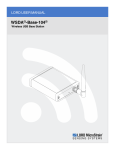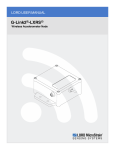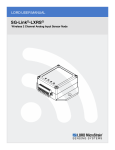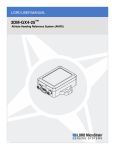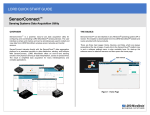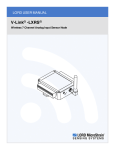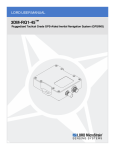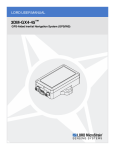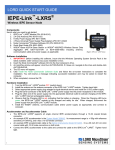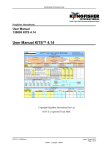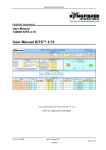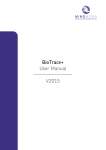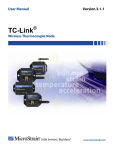Download G-Link - MicroStrain
Transcript
LORD USER MANUAL G-Link®-LXRS® Wireless Accelerometer Node MicroStrain® Sensing Systems 459 Hurricane Lane Suite 102 Williston, VT 05495 United States of America Phone: 802-862-6629 Fax: 802-863-4093 http://www.microstrain.com [email protected] [email protected] Copyright © 2015 LORD Corporation 3DM® , 3DM-DH® , 3DM-DH3™, 3DM-GX1® , 3DM-GX2® , 3DM-GX3® , 3DM-GX4-15™, 3DM-GX4-25™, 3DM-GX4-45™, 3DM-GX4™, 3DM-RQ1™, AIFP® , Ask Us How™, Bolt-Link® , DEMOD-DC® , DVRT ® , DVRT-Link™, EH-Link® , EmbedSense® , ENV-Link™, FAS-A® , G-Link® , G-Link2™, HS-Link® , IEPE-Link™, Inertia-Link® , Little Sensors, Big Ideas.® , Live Connect™, LXRS® , MathEngine® , MicroStrain® , MVEH™, MXRS® , Node Commander ® , PVEH™, RHT-Link® , RTDLink™, SensorCloud™, SG-Link® , Shock-Link™, Strain Wizard® , TC-Link® , Torque-Link™, V-Link® , Watt-Link™, Wireless Simplicity, Hardwired Reliability™, and WSDA® are trademarks of LORD Corporation. Document 8500-0002 Revision C Subject to change without notice. G-Link®-LXRS® Wireless Accelerometer Node User Manual Table of Contents 1. Wireless Sensor Network Overview 6 2. Node Overview 7 3. 4. 5. 2.1 Components List 8 2.2 Interface and Indicators 9 System Operational Overview 10 3.1 Software Installation 11 3.2 System Connections 12 3.3 Gateway USB Communication 13 3.4 Connect to Nodes 14 3.4.1 Adding a Node by Address 14 3.4.2 Using Node Discovery 14 3.5 Channel Configuration 16 3.6 Sampling Settings 18 3.7 Data Acquisition 19 3.8 Data Handling 24 3.9 Connect to SensorCloud™ 25 3.9.1 Sensor Data Files 28 Node Installation 29 4.1 Mounting Recommendations 29 4.2 Sensor Frame 30 4.3 Optimizing the Radio Link 31 4.3.1 Range Test 32 Powering the Node 33 5.1 Selecting the Power Source 33 G-Link®-LXRS® Wireless Accelerometer Node User Manual 5.2 Using the Internal Node Battery 34 5.3 Charging the Node Battery 35 5.4 Connecting an External Power Supply 36 6. Sensor Settings and Operation 37 6.1 Node Channels Designations 37 6.2 Measurement Units 38 6.3 Conversion Values 39 6.4 Operational Considerations 41 6.4.1 Measurement Range 41 6.4.2 Node Sampling Rates 41 6.4.3 Gravity Offset 41 6.5 On-board Temperature Sensor 7. Troubleshooting 42 43 7.1 Troubleshooting Guide 43 7.2 Device Status Indicators 48 7.3 Updating Node Firmware 49 7.4 Repair and Calibration 51 7.5 Technical Support 52 8. Maintenance 53 9. Parts and Configurations 54 9.1 Standard Nodes 54 9.2 Node Accessories 55 9.3 Wireless System Equipment 56 9.4 Product Ordering 57 10. Specifications 58 G-Link®-LXRS® Wireless Accelerometer Node User Manual 10.1 Physical Specifications 58 10.2 Operating Specifications 60 10.3 Power Profile 62 10.4 Radio Specifications 63 11. Safety Information 64 11.1 Battery Hazards 64 11.2 User Configurable Power Settings 65 11.3 Power Supply 66 11.4 ESD Sensitivity 66 12. References 67 12.1 Reference Information 67 12.2 Glossary 68 G-Link®-LXRS® Wireless Accelerometer Node User Manual 1. System Overview Wireless Sensor Network Overview The LORD MicroStrain ® Wireless Sensor Network is a high- speed, scalable, sensor data acquisition and sensor networking system. Each system consists of wireless sensor interface nodes, a data collection gateway, and full-featured user software platforms based on the LORD MicroStrain® Lossless Extended Range Synchronized (LXRS ® ) data communications protocol. Bidirectional wireless communication between the node and gateway enables sensor data collection and configuration from up to two kilometers away. Gateways can be connected locally to a host computer or remotely via local and mobile networks. Some gateways also feature analog outputs for porting sensor data directly to standalone data acquisition equipment. The selection of available nodes allows interface with many types of sensors, including accelerometers, strain gauges, pressure transducers, load cells, torque and vibration sensors, magnetometers, 4 to 20mA sensors, thermocouples, RTD sensors, soil moisture and humidity sensors, inclinometers, and orientation and displacement sensors. Some nodes come with integrated sensing devices such as accelerometers. System sampling capabilities are IEEE 802.15.4-compliant and include lossless synchronized sampling, continuous and burst sampling, and data logging. A single gateway can coordinate many nodes of any type, and multiple gateways can be managed from one computer with the Node Commander® and SensorCloud™ software platforms. Integration to customer systems can be accomplished using OEM versions of the sensor nodes and leveraging the LORD MicroStrain® data communications protocol. Common wireless applications of LORD MicroStrain ® Sensing Systems are strain sensor measurement, accelerometer platforms, vibration monitoring, energy monitoring, environmental monitoring, and temperature monitoring. 6 G-Link®-LXRS® Wireless Accelerometer Node User Manual 2. Node Overview Node Overview The G-Link® -LXRS® wireless sensor node features two integrated high-speed ± 2 g or ± 10 g micro-electro- mechanical (MEMS) accelerometers and an internal temperature sensor. The combined readings from the accelerometers produce a triaxial acceleration output. The node has 12-bit resolution with a measurement bandwidth of 0 to 500 Hz. The node can log data to internal memory and transmit real-time, synchronized data at a wide range of sample rates and intervals. To acquire sensor data, the G-Link -LXRS is used with a LORD MicroStrain data gateway such as the WSDA®-Base or WSDA® -1500 - LXRS®. Figure 1 - G-Link®-LXRS® Wireless Accelerometer Node 7 G-Link®-LXRS® Wireless Accelerometer Node User Manual 2.1 Node Overview Components List The G-Link®-LXRS® sensors and antenna are integrated so there are no external components or removable parts. The node requires a power supply for charging the internal battery and is purchased separately. For a complete list of available configurations, accessories, additional system products and ordering information see Parts and Configurations on page 54. Item A --- Description 1 Charging power supply with plug adapter kit (optional) 1 User Manual, Quick Start Guide and Calibration Certificate 1 Table 1 - Node Components List 8 Quantity G-Link®-LXRS® Wireless Accelerometer Node G-Link®-LXRS® Wireless Accelerometer Node User Manual 2.2 Node Overview Interface and Indicators The G-Link®-LXRS® includes a power input jack for charging the internal battery or externally powering the node, a power on/off switch, a power source selector switch, and mounting holes for device installation. The radio frequency (RF) antenna is internal to the node. The indicators on the G-Link ® -LXRS ® include a device status indicator, a battery charging indicator, a completed charge indicator, and a charge source indicator . The following table describes basic indicator behavior. During data acquisition, the device status indicator has other sequences (see Device Status Indicators on page 48). Figure 2 - Interface and Indicators Indicator Symbol Behavior Node Status Battery charge source indicator OFF No power source detected ON green Charging source detected Battery charging indicator OFF Node not charging ON bright red Node battery charging Completed charge indicator OFF Node charge status unknown ON green Battery fully charged OFF Rapid flashing 1 second pulse Node OFF Node booting up Node active and idle Device status indicator Table 2 - Indicator Behaviors 9 G-Link®-LXRS® Wireless Accelerometer Node User Manual 3. System Operational Overview System Operational Overview The G- Link ® - LXRS ® contains an internal, rechargeable Lithium Polymer (Li-Po) battery. For important precautions see Safety Information on page 64. The G- Link ® - LXRS ® is susceptible to damage and/or disruption of normal operation from Electrostatic Discharge (ESD). For important precautions see Safety Information on page 64. To acquire sensor data, nodes are used with any LORD MicroStrain ® data gateway, such as the WSDA® -Base -10x -LXRS® or WSDA® -1500 - LXRS®, and a software interface. LORD MicroStrain ® has two software programs available for the Wireless Sensor Network: SensorCloud™ and Node Commander ® . SensorCloud™ is an optional web- based data collection, visualization, analysis, and remote management platform based on cloud computing technology. Node Commander ® is used for configuring gateways and nodes, selecting sampling modes and parameters, initializing data acquisition, and viewing and saving data. In this section system hardware and software setup is described, including an overview of the Node Commander ® software menus required to configure a sensor connected to the node and begin data acquisition through the gateway. It is intended as a quick start guide and is not a complete demonstration of all system or software features, capabilities, or settings. Refer to the Node Commander ® User Manual, the LORD MicroStrain ® website, and the SensorCloud™ website for more information (see References on page 67). 10 G-Link®-LXRS® Wireless Accelerometer Node User Manual 3.1 System Operational Overview Software Installation To install Node Commander ® Software Suite on the host computer, run the installer executable file and follow the on-screen prompts for a complete installation. The software is provided with all gateways and is available on the LORD MicroStrain ® website ( see References on page 67). NOTE The Node Commander® software includes hardware drivers required for use with USB gateways. Once installed, the software will automatically detect and configure any USB gateways that are plugged into the host computer. The suite includes the following programs: l l l Node Commander is used for configuring nodes and acquiring, viewing, and saving data. Live Connect™ is a TCP/IP-to-serial conversion tool that translates the communications between Node Commander and an Ethernet gateway. WSDA® Data Downloader is used to download acquired data from the flash memory card embedded in an applicable gateway to a host computer. SensorCloud™ is an optional data collection, visualization, analysis, and remote management tool. It is based on cloud computing technology and is accessed directly from a web connection. Automatic, real- time data collection is available through Ethernet gateways, such as the WSDA® -1500 - LXRS® and any already collected data can be easily uploaded for visualization and analysis. Because it is web-based, SensorCloud™ requires no installation. For more information see Data Handling on page 24. Users can also design custom programs with the open source data communications protocol (see References on page 67). 11 G-Link®-LXRS® Wireless Accelerometer Node User Manual 3.2 System Operational Overview System Connections To acquire sensor data the following components are needed in addition to the node: a LORD MicroStrain® data gateway and a local or networked host computer with access to the data acquisition software (such as Node Commander ® and SensorCloud™). For a connections overview refer to Figure 3 - System Connections . Nodes will communicate with any LORD MicroStrain ® data gateway. The sensor, node, gateway, and software selection is application- dependent, but the basic interfaces are the same. Communication protocols between the gateway and host computer vary depending on which model gateway is used, but they all require interface to a host computer or network. The WSDA® -Base -10x -LXRS ® gateway utilizes local serial connections to the host computer, such as RS232 and USB, and interfaces with the Node Commander® software. The WSDA® 1500 - LXRS ® gateway utilizes Ethernet communications and can be used with Node Commander ® and SensorCloud™, although system configuration is completed using Node Commander® . Gateways with analog outputs can be connected directly to stand-alone data acquisition devices for data collection, however system configuration will still occur through a USB interface to Node Commander®. Users can also write custom programs by utilizing the LORD MicroStrain ® Wireless Sensors Network Software Development Kit (see References on page 67). Figure 3 - System Connections 12 G-Link®-LXRS® Wireless Accelerometer Node User Manual 3.3 System Operational Overview Gateway USB Communication The WSDA-Base USB gateway is used as an example in this quick start guide. For information on how to use other gateways, refer to the gateway or Node Commander ® user manual (see References on page 67). Drivers for the USB gateways are included the Node Commander® software installation. With the software is installed, the USB gateway will be detected automatically whenever the gateway is plugged in. 1. Power is applied to the gateway through the USB connection. Verify the gateway status indicator is illuminated, showing the gateway is connected and on. 2. Open the Node Commander software. 3. The gateway should appear in the Controller window automatically, with a communication port assignment (Figure 4 - USB Gateway Communication). If it is not automatically discovered, verify the port is active on the host computer, and then remove and re-insert the USB connector. Figure 4 - USB Gateway Communication 13 G-Link®-LXRS® Wireless Accelerometer Node User Manual 3.4 System Operational Overview Connect to Nodes Several methods can be used in Node Commander® to establish communication with the nodes. This quick start section covers the two simplest methods; adding a node by address and by using the node discovery feature. 3.4.1 Adding a Node by Address Adding a node by address requires the node to be on the same communication frequency as the gateway. The node address and frequency are indicated in the documentation included with the node when it is purchased. 1. To add a node by address, right-click on the gateway name in the Controller window, and select Add Node > Add Single Node (Figure 5 - Adding a Node by Address). 2. The node address and frequency are indicated in the documentation included with the node when it is purchased. Enter the node address, and select OK. If the node is not found, a message will appear and provide the option to scan for the node on other frequencies. Alternately, the Node Discovery feature can be used. Figure 5 - Adding a Node by Address 3.4.2 Using Node Discovery The Node Discovery feature allows connection between the gateway and node to occur even if they are on different frequencies. To connect to nodes using node discovery, begin by making sure the node(s) are powered off. 14 G-Link®-LXRS® Wireless Accelerometer Node User Manual System Operational Overview NOTE Automatic node discovery may not work in some boot-up modes. If the node is not in normal boot up mode, the assigned one can be bypassed to enable node discovery. For more information see Troubleshooting on page 43. 1. Right-click on the gateway name and select Add Node > Node Discovery (Figure 6 Using Node Discovery). 2. Turn on the node with the node power switch. Within a few seconds during power-up, the node will transmit a message with its operating frequency. 3. When the device status indicator on the node ends the rapid flash sequence and begins pulsing at one- second intervals, it has completed the normal boot- up sequence and is running in idle mode. At this point the node should be listed in the Controller window, and scanning can be stopped by selecting the Stop button in the Node Discovery window. Figure 6 - Using Node Discovery 15 G-Link®-LXRS® Wireless Accelerometer Node User Manual 3.5 System Operational Overview Channel Configuration The sensor settings are stored in the node memory and each sensor is assigned a corresponding channel number. Only the channels and configuration options that are available on the type of node being used will appear in the configuration menus. 1. To enter the configuration menu, right-click on the node name, and select Configure > Configure Node. The Channels tab displays channel options available for the node. a. Channel Enabled: indicates the sensor channel number. The check box is used to enable the channel and select it for sampling. The icon next to the check box describes the channel type inherentto the node being used. b. Current channel configuration: The Data Output, Units, Input Range, and Label fields describe how the channel is currently configured. c. Configure: Select the channel's Configure button to change the channel parameters, such as measurement units, gain and offset settings, and calibration values. The channel must be enabled first by selecting its adjacent check box. Figure 7 - Node Channels Menu 16 G-Link®-LXRS® Wireless Accelerometer Node User Manual System Operational Overview 2. To enter the channel configuration menu, select the Configure button as shown in Figure 7 - Node Channels Menu. The channel configuration menu options change depending on the sensor type selected. a. Channel Label: names the channel b. Channel diagram: shows channel electronics and data flow c. Conversion Coefficients: defines the type and units of the measurement being made d. Sensor Slope: is the sensor sensitivity value used to convert sensor voltage reading to engineering units. For the G-Link -LXRS this value is provided from the factory calibration. e. Conversion Formula and Effective Range: is the formula used to convert sensor readings to engineering units. It also shows the resulting sensor measurement range. Figure 8 - Channel Setup 17 G-Link®-LXRS® Wireless Accelerometer Node User Manual 3.6 System Operational Overview Sampling Settings Sampling settings are accessed through the Configure Node menu. There is a tab for each sampling mode available for the particular node (Figure 9 - Sample Settings Menu).The GLink®-LXRS® has four primary sampling modes: Synchronized Sampling, Low Duty Cycle Sampling, Streaming, and Datalogging. Some modes have user-configurable settings for sample rate, sample duration, and datalogging. Other settings are automatic, depending on number of active channels and other variables. For more information on sampling modes refer to the Node Commander user manual (see References on page 67). NOTE Streaming mode (which enables continuous sampling and transmitting) uses a large amount of system bandwidth and can significantly reduce node battery life. Streaming is recommended primarily for diagnostics and is not supported in SensorCloud™. In general, when determining which sample mode and rate is most suitable for the application, consider the following: l l l 18 Increasing the sample rate or duration reduces the available over- the- air transmission bandwidth and therefore also reduces the number of nodes that can be reporting simultaneously. Increasing the sample rate or duration increases the power requirement of the node and therefore reduces the node's battery life. When measuring vibration or other analog signals, it is important to use a sample rate at least twice the value of the target measurement frequency. This is the minimum sample rate required to produce an accurate digital representation of the measured signal. The higher the sample rate, the more accurate the digital representation. G-Link®-LXRS® Wireless Accelerometer Node User Manual System Operational Overview Figure 9 - Sample Settings Menu 3.7 Data Acquisition NOTE Once sampling has started it will continue as configured without the need to leave Node Commander® open. However, if the node is powered off and is not configured to sample on boot- up, data acquisition will end and must be restarted in Node Commander®. When data acquisition is started, each of the sampling modes has different menu options and views. Some open a settings menu before data acquisition begins and may include a data list view and/or a graph view. The following is an example of Synchronized Sampling (Figure 10 Starting a Sampling Session). For more information about synchronized sampling and using the gateway beacon see Data Acquisition on page 19. For more information about other sampling modes, refer to the Node Commander® user manual. (see References on page 67). To start a sampling session, nodes can be selected individually or as a group. When selected as a group, they will all be set to the same sampling mode. Right-click on the nodes and select Sample > Synchronized Sampling. 19 G-Link®-LXRS® Wireless Accelerometer Node User Manual System Operational Overview Figure 10 - Starting a Sampling Session When a synchronized sampling session is started, the sampling menu appears and includes settings to enable optional sampling features, configure nodes, and to specify where the data will be saved. The built-in bandwidth calculator displays the total bandwidth used by the nodes selected for synchronized sampling (Figure 11 - Synchronized Sampling Menu). a. Save Location: indicates where the data file will be saved on the host computer. Use the Browse button to select a preferred location. b. Node configuration: includes the node serial number, sampling settings, bandwidth calculation, and current status. Highlight any node or group of nodes, and the Remove, Configure, and Refresh buttons become active. The Configure button opens the node configuration menus to adjust settings as needed and recalculates the node bandwidth. Multiple nodes can be configured together by using the Shift or Ctrl key to select them. c. Lossless: enables the lossless data protocol. The protocol enables buffering and retransmission of data in order to provide 100% data collection success. Using this feature may increase data display latency. 20 G-Link®-LXRS® Wireless Accelerometer Node User Manual System Operational Overview Figure 11 - Synchronized Sampling Menu d. High Capacity: reduces the transmit rates in order to optimize bandwidth and power savings among nodes with slower sample rates. e. Network Bandwidth: is the total bandwidth used by all the nodes. f. Enable Beacon on Start: When synchronized sampling is started the nodes wait for the first beacon transmission to initiate sampling. When this option is selected (default), the gateway beacon is enabled and will begin transmitting at a fixed interval when sampling is started. Disabling the beacon on start (unchecking the box) will set the nodes to wait for the beacon, but it does not actually start the beacon when sampling is started. This can be used if there is a need for sampling to be initiated later, or if the beacon is being received from another source than the gateway. Enabling the beacon in this way is the same as enabling the beacon in the gateway menu Refer to the Node Commander® User Manual for more information . g. Apply settings and start sampling: Before acquisition can begin, use the Apply Network Settings to save the session settings to the node. When completed, select Start Sampling to begin. h. Close sampling window (with the red "X") to exit sampling or, once the sampling has been started, to view the data window behind it. 21 G-Link®-LXRS® Wireless Accelerometer Node User Manual System Operational Overview Synchronized sampling features two data views: Grid view and Graph view. Once sampling is started, the data grid view is the default view (Figure 12 - Synchronized Sampling Data View). NOTE When synchronized sampling is set to slower sample rates it may take several seconds after sampling is initiated for the first sample to appear. Figure 12 - Synchronized Sampling Data View a. Device status: Node sampling mode and gateway status are displayed in parentheses next to the device name. b. Node information: includes node serial number and sampling statistics. Rightclick on the node name for more menu options such as Stop Nodes. c. Data: is a display of the sampled data with each channel in a column. d. Radio strength: indicates how good the communication is between the gateway and node. See Range Test on page 32. e. Data file: the location and size of the data file, as data is added. View the data in .CSV format with the Open File button. f. View menu: Select between Data Grid and Graph views. g. End sampling: The red "X" is used to exit the sampling window and/or end sampling. 22 G-Link®-LXRS® Wireless Accelerometer Node User Manual System Operational Overview Use the view menu to select the Graph view of the data (see Synchronized Sampling Graph View on page 23). Click on the node name to view the graph for that node. Click again to hide it. Figure 13 - Synchronized Sampling Graph View a. Available Nodes: Click on the node to display the graph for that node. Click again to hide it. Right-click on the node name for more menu options such as Stop Nodes and Save Stream. b. Axis range: Select the X-axis width and Y-axis zoom percentage, or use the Auto check box for automatic scaling. c. Graph: The node graph shows the sampled data. Each active channel is displayed in a different color. The X-axis is time in seconds and the Y-axis is the A/D value (bits). Right click on the graph for additional menu options such as View Graph Key, Pan, Zoom, Pause, and Remove Graph. d. View menu: Select between Data Grid and Graph views. e. Data file: The location and size of the data file as data is added. View the data in .CSV format with the Open File button. f. End sampling: The red "X" is used to exit the sampling window and/or end sampling. 23 G-Link®-LXRS® Wireless Accelerometer Node User Manual 3.8 System Operational Overview Data Handling Data acquired through Node Commander ® is automatically saved on the host computer (see Sensor Data Files on page 28) and can also be viewed from the web-based SensorCloud™ portal. Saved data can be uploaded to SensorCloud™ and Ethernet gateways provide the option to automatically port the data to SensorCloud™ during data acquisition for near realtime display and aggregation. SensorCloud™ is based on cloud computing technology and is designed for long term collecting and preservation of data. Features include time series and visualization graphing, automated alerts, and data interpretation tools such as data filtering, statistical analysis, and advanced algorithm development with the integrated MathEngine ® interface. Leveraging the open source API, SensorCloud™ can also be used to collect data from other LORD MicroStrain ® sensor products or third- party systems. Basic SensorCloud™ services are available to all users free of charge (see Connect to SensorCloud™ on page 25). Figure 14 - Data Storage, Display and Processing 24 G-Link®-LXRS® Wireless Accelerometer Node User Manual 3.9 System Operational Overview Connect to SensorCloud™ Ethernet gateways, such as the WSDA ® -1500 - LXRS ® can be enabled to upload data automatically to SensorCloud once the node sampling has been activated. Refer to the gateway user manual for more information. To connect to SensorCloud go to the SensorCloud website log-in page, and enter the log-in credentials. Register as a new user if needed. http://sensorcloud.com/log-in/ Figure 15 - SensorCloud™ Log-in or Register The SensorCloud interface has six main views. When logging in as a registered user, the Device view is the default. Navigate to other views by clicking the view name at the top of the page (Figure 16 - SensorCloud™ Menu Views). The Data and Settings views are only available once a device is selected from the device list. Figure 16 - SensorCloud™ Menu Views 25 G-Link®-LXRS® Wireless Accelerometer Node User Manual System Operational Overview Device - The device list shows every gateway and API device associated with the SensorCloud account, including owned, shared, and demo devices. This view provides links to each device’s SensorCloud subscription plan, configuration options, and a summary of last communications and data transactions. Account - The account view is for logistic management of the SensorCloud account, such as changing the log-in password, user email, and billing information. CSV Uploader - The data upload feature enables data from any source (such as non-Ethernet LORD MicroStrain gateways, or third- party sensor) to be uploaded to the SensorCloud platform. The data must be in the LORD MicroStrain CSV format. Data - This view is only available after a device is selected. It displays data that is collected from sensor nodes or uploaded from files. Data selections are listed by node channel or a userdefined label, and can be enabled for display in the graph window. The interactive graph has navigational features such as panning, zooming, and an overview graph for single-click access to data points or ranges. There are also use and management features such as viewing the meta-data and downloading, embedding, and tagging data graphs. Figure 17 - SensorCloud™ Data View Settings - The settings view provides options for adding meta- data, configuring the data displays for each channel, creating alerts based on data thresholds, setting the data timezone, and more. MathEngine ® - is used to analyze sensor data. Functions include the ability to filter out frequencies, smooth out noisy data, perform math operations such as Fast Fourier Transforms 26 G-Link®-LXRS® Wireless Accelerometer Node User Manual System Operational Overview (FFTs), and more ( Figure 18 - MathEngine® View ) . MathEngine ® interfaces with the SensorCloud graphing view for faster processing. Users can write their own algorithms for custom applications. Refer to the MathEngine® website for more information. http://sensorcloud.com/mathengine For more information about SensorCloud features and navigation, refer to the SensorCloud website or contact LORD MicroStrain Technical Support. http://sensorcloud.com Figure 18 - MathEngine® View Figure 19 - FFT Graph in SensorCloud™ 27 G-Link®-LXRS® Wireless Accelerometer Node User Manual 3.9.1 System Operational Overview Sensor Data Files Data acquired in Node Commander is stored in .CSV format and can be opened with Microsoft Excel, Quattro Pro, Open Office, or other CSV editors/spreadsheet programs. Data in this format is easily uploaded to SensorCloud™ using the CSV Uploader. The data files can be found on the host computer in the default directory or the location specified at the beginning of sampling (as applicable). The files are organized in separate folders by mode and then further categorized by date, session, and/or node serial number. The default directory is: C:\ProgramData\Microstrain\NodeCommander\SampledData Synchronized sampling and low duty cycle files are found in the Sampled Data folder. Datalogging files need to be downloaded from the node before they are available for viewing. They can be accessed through datalogging menus as well as the File menu. They are stored by default in the Downloaded Triggers folder. Streaming data is stored in the Streaming folder. Figure 20 - Exploring Data 28 G-Link®-LXRS® Wireless Accelerometer Node User Manual 4. Node Installation Node Installation 4.1 Mounting Recommendations The G-Link®-LXRS® is rated for indoor use only, unless housed in a ruggedized outdoor enclosure. Enclosures for the G-Link® -LXRS® are available from LORD MicroStrain®. Some also accommodate D cell batteries, extending the battery operating capacity and duration. For more information see Node Accessories on page 55. There are two mounting tabs on the node, with holes for fastening. For proper coupling of the accelerometer to the substrate being measured, it is recommended that the node or external sensor (if applicable) be mounted with fasteners on a rigid surface. This will reduce higher frequency losses. The node can be mounted in any orientation, but it is recommended that it is mounted in a way that optimizes wireless communications. In the G-Link®-LXRS® , the accelerometers should be positioned as required for the application ( see Sensor Frame on page 30 ) . For more information see Optimizing the Radio Link on page 31. Figure 21 - Mounting the Node 29 G-Link®-LXRS® Wireless Accelerometer Node User Manual 4.2 Node Installation Sensor Frame During installation, the internal accelerometers are oriented such that the axis are aligned appropriately for the measurement application. The axis orientation is referred to as the sensor frame and is indicated on the device information label (Figure 22 - Sensor Frame). Each axis has a corresponding channel designation in the G- Link ® - LXRS ® software ( see Channel Configuration on page 16). Figure 22 - Sensor Frame 30 G-Link®-LXRS® Wireless Accelerometer Node User Manual 4.3 Node Installation Optimizing the Radio Link In ideal conditions, the nodes and gateway can communicate up to two kilometers apart. In order to accomplish this, the node and gateway must be installed in a manner that optimizes the wireless transmission. The G-Link ® -LXRS ® operates at a 2.4GHz transmission frequency. The internal antenna has an omni-directional radiation pattern. Using any other antenna with the node will void FCC compliance. The best method for ensuring optimal radio communication is to conduct an RF survey of the installation site. This is easily accomplished in Node Commander ® by using the range test feature to quantify the radio signal strength (RSSI) in various scenarios. See Range Test on page 32 for instructions on using Node Commander ® for measuring RSSI. The following are general guidelines for maximizing transmission range: l l l l 31 Establish Line of Sight (LOS) between the node and gateway antenna as best as possible. Try to avoid obstructions between the antennas, such as buildings, terrain, vegetation, or other physical barriers. Increase the mounting height of the node to allow a clearer LOS path to the gateway. Height above the ground is also important because reflections off of the ground can interfere at the receiver. Generally, the higher above the ground the better. Minimize Radio Frequency Interference (RFI) such as other equipment antennas, especially those operating in the same frequency range. This includes other nodes. If other antennas are required nearby, mount them at different heights to minimize interference. Additionally, the specific node frequency is selectable within its operational range using the Node Commander® software. Set the devices to different transmission frequencies. Minimize Electromagnetic Interference (EMI) such as that which is generated by power transmission equipment, microwaves, power supplies, and other electromagnetic sources. Metal Objects in close proximity to either antenna, particularly ferrous metals such as steel and iron, can be problematic for wireless communications. The larger the object, the greater the influence. G-Link®-LXRS® Wireless Accelerometer Node User Manual 4.3.1 Node Installation Range Test After establishing communication between node and gateway, use the range test feature in Node Commander ® to monitor the signal strength and to optimally position the nodes, gateway, and antennas for installation. Maximum achievable range is determined by the gateway and node power settings (found in the device Configure menu) and is highly dependent on the physical environment surrounding the devices. 1. Right-click on the node header, and select Communicate > Range Test. Figure 23 - Range Test Menu 2. The total RSSI range for the node and gateway is -90 to 0dBm. The higher the value (closer to zero), the better, but reliable communication can be achieved between - 75 dBm and 0 dBm. The devices is still able to communicate between -90 dBm and -75 dBm, but it could be intermittent or result in data loss. Position the node and gateway antennas where the best RSSI value is observed. Figure 24 - Range Test Statistics 32 G-Link®-LXRS® Wireless Accelerometer Node User Manual 5. Powering the Node Powering the Node Apply only the input voltage range specified for the node in the polarity indicated. Failure to do so could result in personal injury and permanent damage to the node ( see Safety Information on page 64). The node can be powered with either the internal battery or an external source. These sources cannot be used simultaneously; there is switch on the node to select which source to use. When the node is manufactured, the switch is set to operate using the internal battery. External battery holders are also available for the G-Link ® -LXRS ® and can be used to extend battery operating capacity and duration. For more information see Node Accessories on page 55. 5.1 Selecting the Power Source There is user-accessible switch to select the power source. 1. Verify the node power switch is in the OFF position and no external power is applied. 2. Use a small flat-head screwdriver to push the recessed switch fully to the desired position, as indicated in Figure 25 - Power Source Selection. The figure shows the node configured for an internal power source. Figure 25 - Power Source Selection 33 G-Link®-LXRS® Wireless Accelerometer Node User Manual 5.2 Powering the Node Using the Internal Node Battery The G- Link ® - LXRS ® contains an internal, rechargeable Lithium Polymer (Li-Po) battery. For important precautions see Safety Information on page 64. When the internal node switch is set for internal power, the node is powered by a rechargeable, 220 mAH lithium polymer battery. This battery is not user-serviceable. Node battery life is highly dependent on operational parameters such as sample mode and rate. More active channels and higher sample rates equate to decreased battery life. The following graph shows an example approximation of the battery life for a G-Link®-LXRS®over a range of sample rates operating in Synchronized Sampling mode. For additional G-Link®LXRS® power specifications see Power Profile on page 62. 34 G-Link®-LXRS® Wireless Accelerometer Node User Manual 5.3 Powering the Node Charging the Node Battery Use only the power supply specified for the node to charge the battery. Using a power supply above the rated voltage could cause personal injury and permanent damage to the node. For important safety considerations see Safety Information on page 64. NOTE Touching sensors or charging the node battery while acquiring data may induce noise on sensitive sensor signals and is not recommended. 1. Turn the node power switch off, and plug the node power supply into the node and then into a 120/240VAC, 50/60Hz AC power source. Use only the power supply specified for the node. Use the supplied power plug adapters, as needed. 2. Monitor the status of the charge indicators. For indicator meaning see Device Status Indicators on page 48. Continue charging until the indicator turns green to indicate a completed charge. Charging takes approximately 6-8 hours from a full depletion. Figure 26 - Node Charging 35 G-Link®-LXRS® Wireless Accelerometer Node User Manual 5.4 Powering the Node Connecting an External Power Supply Apply only the input voltage range specified for the node in the polarity indicated. Failure to do so could result in personal injury and permanent damage to the node ( see Safety Information on page 64). When the internal node switch is set for external power, the node may be directly powered by the power supply specified for charging the node (or another regulated AC to DC power supply with the appropriate output parameters, see Operating Specifications on page 60). It can also be powered by an external battery or other regulated DC supply. The supply must deliver a stable voltage between 3.2 and 9.0 V dc and be capable of sourcing at least 100 mA. External battery holders and ruggedized outdoor housings that accommodate D cell batteries are available for the G-Link®-LXRS® (see Node Accessories on page 55). External power is applied through the power supply jack, Observe connection polarities, or the node may be damaged. Figure 27 - External Power Connections 36 G-Link®-LXRS® Wireless Accelerometer Node User Manual 6. Sensor Settings and Operation Sensor Settings and Operation . The node configuration interface includes settings for measurement units and conversion values. The G-Link®-LXRS® sensors are calibrated at the factory and require no user adjustment of the conversion values. There are preset measurement units, as well as a user-defined field. Because the wireless sensor system is digital, the analog voltage readings from the sensors are converted into a digital equivalent value based on the volt-to-bit scale of the internal analog-to-digital voltage converter (A/D converter). Sensor readings can be displayed and recorded in A/D value (bits) directly or further converted to engineering units by applying conversion values and a conversion formula. For more information see Conversion Values on page 39, and for instruction of adjusting units see Measurement Units on page 38. 6.1 Node Channels Designations Sensors are assigned to a specific channel number at the factory and cannot be changed. For sensor orientation information see Sensor Frame on page 30. Channel Description 1 2 3 4 accelerometer channel 1 (x-axis) accelerometer channel 2 (y-axis) accelerometer channel 3 (z-axis) temperature channel Table 1 - Channel Designations 37 G-Link®-LXRS® Wireless Accelerometer Node User Manual 6.2 Sensor Settings and Operation Measurement Units Sensor measurement units are set in the channel Configuration menu. 1. To enter the Configuration menu, right-click on the Node heading, and select Configure > Configure Node. The Channels tab displays channel options available for the current node. Figure 28 - Channel Configuration Menu 2. Select the type of measurement from the Class menu, and then select Units. Figure 29 - Select Sensor Units 38 G-Link®-LXRS® Wireless Accelerometer Node User Manual 6.3 Sensor Settings and Operation Conversion Values The conversion values for the G- Link ® - LXRS ® are determined when the device is calibrated at the factory, and they require no user adjustment. Three types of calibrations are available depending on the level of accuracy required for the application: a standard calibration, a NIST-traceable, or ASTM-traceable calibration. For more information see Parts and Configurations on page 54. For applications with unique installation conditions it may be desirable to adjust the conversion offset value or perform a field calibration. To determine if this is appropriate, contact LORD MicroStrain® Technical Support (see Technical Support on page 52). The conversion values include the slope, offset, and formula for converting the sensor A/D value (bits) to engineering units. The bits are the digital representation of the sensor voltage output. The type of sensor, channel, and desired engineering units determine what conversion values are available. The conversion values are entered via the Node Commander® and saved in the node memory for the applicable channel. The conversion values can be entered in two menus (Figure 30 - Abbreviated Conversion Values Menu and Figure 31 - Advanced Conversion Values Menu ) . The channel Configuration menu has more options than the Calibration Coefficients menu, but both are acceptable ways to enter the values and formulas. Figure 30 - Abbreviated Conversion Values Menu 39 G-Link®-LXRS® Wireless Accelerometer Node User Manual Sensor Settings and Operation Figure 31 - Advanced Conversion Values Menu Conversion Formula: The conversion formula assumes a linear relationship between the original units (such as A/D bits) and new engineering units (such as g -force ), and it is expressed mathematically as y=mx+b, where y is the engineering units at a given point (measurement), m is the slope of the line that represents the linear ratio, x is the original unit value at a given point, and b is a unit conversion offset (in the case of unit conversions) or the fixed zero load offset of the sensor (in the case of measurement calibration coefficients). Negative values may be entered for any coefficient. Slope: is the linear scaling slope coefficient. The slope is the ratio of original units to new engineering units (EU), and it is used to convert the sensor measurements. The slope conversion value will vary depending on the engineering units desired. For example if the original unit is A/D values (bits), and the desired engineering units are acceleration in gforce, the slope conversion would describe how many bits equal one unit of g-force (bits/g). Mathematically, the slope is m in the formula y = mx +b. Offset: is the linear scaling offset coefficient, and it is typically the starting output value of the sensor with no load applied (in the original units). Mathematically, the offset is b in y = mx +b. Effective Range: the effective range is the calculated sensor measurement range in engineering units (EU). The effective range is dependent on the slope, offset and resolution of the node. The effective range is the number of bits per EU unit (slope) multiplied by the total number of bits, minus the offset (if applicable). 40 G-Link®-LXRS® Wireless Accelerometer Node User Manual 6.4 Sensor Settings and Operation Operational Considerations 6.4.1 Measurement Range The accelerometer bandwidth limits the range of frequencies that can be measured. As the measured vibration frequency approaches the upper bandwidth limitation of the accelerometer, the accelerometer sensitivity decreases. The result is a predictable reduction in the measured vibration amplitude when measuring beyond the bandwidth limit. The bandwidth limitation is indicated in the node specifications (see Specifications on page 58). The low pass filter cutoff frequency setting (see Channel Configuration on page 16) limits the measured readings that will be reported based on the frequency of the signal. Frequency readings above the selected setting will decrease in amplitude, just as with the accelerometer bandwidth limit. For best performance select a cutoff frequency that is no more than half of the sample rate. For example, if the target measurement is 100 Hz, and the sample rate is set to 500 Hz, set the cutoff frequency between 100 Hz and 250 Hz. 6.4.2 Node Sampling Rates The G-Link ® -LXRS® is capable of sampling up to 4096 Hz . For measuring vibration it is recommended to use a sample rate at least twice the value of the target frequency. This is the minimum sample rate required to produce an accurate digital representation of the measured signal. For example, if the target measurement is 100 Hz, the sample rate should be set to 200 Hz or higher. While the G-Link®-LXRS® is capable of high sample rates and high resolution conversions, the integrated accelerometer may limit performance in certain circumstances. For example, even though the G-Link ®-LXRS® can sample up to 4096 Hz , the integrated accelerometer (in the standard configuration) only has a bandwidth of500 Hz. Setting the node to sample at 4096 Hz would result in oversampling by a factor of about 8 , which is well over typical practices. Oversampling by a factor of 4 times is enough for most applications. 6.4.3 Gravity Offset During data acquisition it is normal to see up to -1g offset due to the effects of gravity on the sensor axis (Figure 32 - Gravity Offset). For more information on the sensor reference frame see Sensor Frame on page 30. 41 G-Link®-LXRS® Wireless Accelerometer Node User Manual Sensor Settings and Operation Figure 32 - Gravity Offset 6.5 On-board Temperature Sensor l l l 42 The G-Link® -LXRS® has an on-board, solid state temperature sensor mounted on the surface of the circuit board. The temperature sensor output is connected to channel 4 of the G-Link®-LXRS® Refer to the node specification table for the temperature sensor operating parameters (see Operating Specifications on page 60). G-Link®-LXRS® Wireless Accelerometer Node User Manual 7. Troubleshooting 7.1 43 Troubleshooting Guide Troubleshooting G-Link®-LXRS® Wireless Accelerometer Node User Manual Problem Troubleshooting Possible cause and recommended solution 1.1 node or gateway power is off 1. POWER gateway or node does not turn on, or node does not charge The status indicator LED on the device may be off. Turn the device on, and the status indicator LED should illuminate. 1.2 external power is off or miswired Verify the device power source is connected correctly and powered on. 1.3 wrong power supply Using a power supply other than the one specified for the device (or an external supply that is outside of the device operating range) could result in permanent damage to the device or cause it to not work properly. 1.4 node internal source select switch is incorrect When the node is manufactured, it is set to internal battery operation, but it can be configured to accept an external source. When set to accommodate an external source, the battery cannot be charged. 1.5 node battery is dead If the node power source selector is set to internal, and the node will not power on or charge, the node battery may need to be replaced. Contact LORD MicroStrain ® Technical Support (See Technical Support on page 52). 1.6 node battery fault If the battery charge indicator on the node is only dimly illuminated when charging is attempted, a battery fault condition has occurred. Unplug power, and then plug it back in. The indicator should turn on brightly, indicating charging. 1.7 node or gateway is damaged If all power settings and connections have been verified, and the node is still unresponsive, contact LORD MicroStrain ® Technical Support (See Technical Support on page 52). 2.1 node or gateway has no power 2. COMMUNICATION 44 G-Link®-LXRS® Wireless Accelerometer Node User Manual Problem no communication to the gateway or node Troubleshooting Possible cause and recommended solution Verify the node and gateway have power applied and that applicable power switches are on. Power is indicated on both devices by a status indicator LED. 2.2 gateway has no communication with the computer Verify gateway communication in the software. Check, remove, and reconnect communications and power cables as applicable. l l l For serial gateways, verify that the COM port setting. For USB gateways, verify that the drivers are installed on the computer (included with Node Commander®) and that the software has had sufficient time to detect it. For Ethernet gateways, use Live Connect™ to verify communications on a DHCP network. Check that the extended timeouts are enabled in the Node Commander® Edit > Preferences menu, under Devices. Once communication has been established, the network configuration can be changed. 2.3 node cannot be configured Observe the node status indicator LED to determine the device's state: boot, idle, sample, or sleep. If the node is sampling or sleeping, it cannot be configured. In Node Commander ® , execute the Stop Node command to put the node in idle state, allowing configuration to occur. If the user inactivity timeout is set very low, the configuration menu will have to be entered quickly, before the timeout occurs, putting the node back in a sample or sleep state. 2.4 node is out of range Perform a bench test with the node in close proximity to the gateway to verify they are operational. For range test and installation recommendations see Range Test on page 32. The system has been tested to operate with the node and gateway up to 2 km apart with clear line of sight. 2.5 node is not in normal boot mode 45 G-Link®-LXRS® Wireless Accelerometer Node User Manual Problem Troubleshooting Possible cause and recommended solution If the node status indicator shows the node booting in a mode other than the normal boot mode, it can be bypassed by toggling the node ON/OFF switch rapidly three times, then leaving it in the ON position for normal power up. In normal boot mode the communication can be established with automatic node discovery (or manually) once the boot process is complete and the node is in idle state. Start-up mode can then be changed in the software. 2.6 node is sampling Observe the node status indicator LED to determine the device's state: boot, idle, sample, or sleep. If the node is sampling, it cannot be configured. In Node Commander ® , execute the Stop Node command to put the node in idle state, allowing configuration to occur. 2.7 node is sleeping Observe the node status indicator LED to determine what state it is: boot, idle, sample, or sleep. If the node is sleeping, it cannot be configured. In Node Commander ® , execute the Stop Node command to put the node in idle state, allowing configuration to occur. 2.8 gateway or node is damaged Verify all connections, power, and settings. If available, try installing alternate nodes and gateways one at a time to see if the faulty device can be identified. If no conclusion can be determined or to send a device in for repair, contact LORD MicroStrain ® Technical Support ( See Technical Support on page 52). 3.1 no communication to node or gateway 3. DATA ACQUISITION sensor data is missing or incorrect Verify connections and power to the node and gateway. Verify they are powered on and communicating with the software. Enter a configuration menu to verify that the node can be accessed. 3.2 sampling settings are incorrect If the sampling mode, rate, or duration are not performing as expected, enter the node configuration menu, and verify the 46 G-Link®-LXRS® Wireless Accelerometer Node User Manual Problem Troubleshooting Possible cause and recommended solution sampling settings. 3.3 sampling has not started If sampling is occurring, the sampling mode will be displayed next to the node name in Node Commander®. The node device status indicator will also be flashing the sampling mode code. If the node is not sampling, activate it in the software or with a sample on start up boot sequence. 47 G-Link®-LXRS® Wireless Accelerometer Node User Manual 7.2 Troubleshooting Device Status Indicators The following is a complete list of the G-Link®-LXRS® status indicators. Indicator Symbol Behavior Node Status Battery charge source indicator OFF No power source detected ON green Charging source detected Battery charged indicator OFF Node not charging ON bright red Node battery charging OFF ON green ON green and battery charging indicator ON red OFF Node charge status unknown Battery fully charged Battery fault condition. Reset by unplugging power and then plugging it back in Node OFF or sleeping Node sleeping with radio check intervals enabled (default is every 5 seconds) Completed charge indicator OFF, with occasional flash Ten rapid flashes when power is initially applied 1 second pulse Device status indicator Continuously ON 1 Hz pulse green Pulses for each ping Four to seven slow pulses when power is initially applied Node booting normally and sending out a status message Node active and idle Node datalogging or streaming data Node is sampling in low duty cycle or synchronized sampling Node is sending out communication requests (such as in ping command, range test, or EEPROM read/write) Fault condition Table 3 - Device Status Indicators 48 G-Link®-LXRS® Wireless Accelerometer Node User Manual 7.3 Troubleshooting Updating Node Firmware Under the recommendation of LORD MicroStrain ® Technical Support Engineers, nodes can be upgraded to the latest available firmware to take advantage of new features or correct operating issues. Node Commander ® version 2.7.0 or greater can be used to update any mXRS® or LXRS® node or gateway firmware to the most current version. Updates are found on the LORD MicroStrain ® website. See Technical Support on page 52 for contact and website information. 1. Download the LXRS® Firmware Upgrade file from the LORD MicroStrain® website. 2. Once downloaded, extract the contents of the .zip file into a folder on the computer. Verify there is a file with a .zhex extension. 3. Launch Node Commander ® , and establish communication between the node and gateway as normal. 4. While holding F1 button on the keyboard, right-click the node name, and a drop-down menu will appear. Figure 33 - Update Node Firmware 49 G-Link®-LXRS® Wireless Accelerometer Node User Manual Troubleshooting 5. Release the F1 key. 6. Click Upgrade Firmware, and the Node Firmware Upgrade window will appear. 7. Click Browse, and navigate to the downloaded .zhex file. 8. Click Write, and the upgrade sequence will begin. When completed, "Upgrade Success" will appear in the Status column. Figure 34 - Upgrade Firmware Window 50 G-Link®-LXRS® Wireless Accelerometer Node User Manual 7.4 Troubleshooting Repair and Calibration The G-Link®-LXRS® is factory calibrated when it is manufactured. No further calibration is required. General Instructions In order to return any LORD MicroStrain ® product, you must contact LORD MicroStrain ® Sales or Technical Support to obtain a Return Merchandise Authorization number (RMA). All returned merchandise must be in the original packaging including manuals, accessories, cables, etc. with the RMA number clearly printed on the outside of the package. Removable batteries should be removed and packaged in separate protective wrapping. Please provide the LORD MicroStrain ® model number and serial number as well as your name, organization, shipping address, telephone number, and email. Normal turnaround for RMA items is seven days from receipt of item by LORD MicroStrain®. Warranty Repairs LORD MicroStrain ® warrants its products to be free from defective material and workmanship for a period of one (1) year from the original date of purchase. LORD MicroStrain ® will repair or replace, at its discretion, a defective product if returned to LORD MicroStrain® within the warranty period. This warranty does not extend to any LORD MicroStrain® products which have been subject to misuse, alteration, neglect, accident, incorrect wiring, misprogramming, or use in violation of operating instructions furnished by us. It also does not extend to any units altered or repaired for warranty defect by anyone other than LORD MicroStrain®. Non-Warranty Repairs All non- warranty repairs/replacements include a minimum charge. If the repair/replacement charge exceeds the minimum, LORD MicroStrain ® will contact the customer for approval to proceed beyond the minimum with the repair/replacement. 51 G-Link®-LXRS® Wireless Accelerometer Node User Manual 7.5 Troubleshooting Technical Support There are many resources for product support found on the LORD MicroStrain ® website, including technical notes, FAQs, and product manuals. http://www.microstrain.com/support_overview.aspx For further assistance our technical support engineers are available to help with technical and applications questions. Technical Support [email protected] Phone: 802-862-6629 Fax: 802-863-4093 SKYPE: microstrain.wireless.support Live Chat is available from the website during business hours: 9:00 AM to 5:00 PM (Eastern Time US & Canada) 52 G-Link®-LXRS® Wireless Accelerometer Node User Manual 8. Maintenance Maintenance There are no user-serviceable parts on the G-Link ®-LXRS®. For device service and repair contact LORD MicroStrain ® Technical Support (see Technical Support on page 52). Opening the device will void the product warranty. 53 G-Link®-LXRS® Wireless Accelerometer Node User Manual 9. Parts and Configurations Parts and Configurations 9.1 Standard Nodes For the most current product information, custom, and OEM options not listed below, refer to the LORD MicroStrain® website or contact the LORD MicroStrain® Sales Department. Model Number Description l G-LINK-LXRS-2G l l G-LINK-LXRS-10G l Internal ±2 g tri-axial accelerometer LORD MicroStrain® Part Number 6305-2000 Internal temperature sensor Internal ±10 g tri-axial accelerometer 6305-3000 Internal temperature sensor Calibration Options (required for use - specify at time of order) The G-Link -LXRS is available in three versions based on the user-selected calibration option. The products look and perform a little differently, and should be selected based on the application. The three calibration options are Standard, NIST, and ASTM. Refer to the operating and mechanical specifications for details (see Specifications on page 58), and the applicable Technical Note (see References on page 67). l l l 54 Standard calibrations normalize each sensor channel to the rotation of the Earth's gravitational field. This is the least accurate calibration. NIST traceable calibrations normalize each sensor channel to a reference accelerometer that is traceable to the National Institute of Standards and Testing (NIST) criteria. ASTM traceable calibrations normalize each sensor channel to a reference accelerometer that is traceable to the American Society for Testing and Materials (ASTM) F2137 criteria. This criteria was developed by ASTM specifically for measuring the dynamic characteristics of amusement park rides. This is the most accurate calibration option. G-Link®-LXRS® Wireless Accelerometer Node User Manual 9.2 Parts and Configurations Node Accessories The following parts are available for use with the G-Link®-LXRS®. For the most current product information, custom, and OEM options not listed below, refer to the LORD MicroStrain ® website or contact the LORD MicroStrain® Sales Department. See Product Ordering on page 57. Description Charging power supply for G-Link®-LXRS® with international plug adapters IP66/NEMA4 rated rugged outdoor enclosure for G-Link®-LXRS® IP66/NEMA4 rated rugged outdoor enclosure for G-Link®-LXRS® with two D cell battery capacity IP66/NEMA4 rated rugged outdoor enclosure for G-Link®-LXRS® with three D cell battery capacity D cell battery tray for use with wireless nodes (indoor use) AA cell battery tray for use with wireless nodes (indoor use) Lithium D cell battery 19 Ah capacity Lithium AA cell battery 2 Ah capacity Table 4 - Node Accessories 55 LORD MicroStrain® Part Number 6302-1000 6306-0100 6306-0200 6306-0300 6302-0200 6302-0300 6302-0000 6302-0100 G-Link®-LXRS® Wireless Accelerometer Node User Manual 9.3 Parts and Configurations Wireless System Equipment The following system parts are available for use with the G-Link®-LXRS®. For the most current standard, custom, and OEM product options, refer to the LORD MicroStrain ® website or contact the LORD MicroStrain® Sales Department. See Product Ordering on page 57. Model Description WSDA-1500-SK -- Ethernet Data Gateway Starter Kit Node Commander® Software SensorCloud™ Software Subscription (contact LORD MicroStrain® Sales) USB Gateway Starter Kit RS232 Gateway Starter Kit. Analog Gateway Starter Kit Replacement USB cable USB Gateway cable extender Replacement serial cable Ethernet Data Gateway Ethernet Data Gateway (ruggedized to MILS-STD-461F/MIL-STD 810F) USB Gateway RS232 Serial Output Gateway Analog Output Gateway Wireless Accelerometer Node Wireless 2-Channel Analog Input Sensor Node Wireless 2-Channel Analog Input Sensor Node Wireless 7-Channel Analog Input Sensor Node Wireless IEPE Accelerometer Node -WSDA-BASE-104-SK WSDA-BASE-102-SK WSDA-BASE-101-SK ---WSDA-1500 WSDA -RGD WSDA-BASE-104 WSDA-BASE-102 WSDA-BASE-101 G-Link2-LXRS SG-Link-LXRS SG-Link-OEM V-Link-LXRS IEPE-Link -LXRS Table 5 - Wireless System Equipment 56 LORD MicroStrain® Part Number 6314-1501 6301-0300 -6307-1041 6307-1021 6307-1011 9022-0029 6307-0900 4005-0005 6314-1500 6314-1050 6307-1040 6307-1020 6307-1010 various models various models various models various models various models G-Link®-LXRS® Wireless Accelerometer Node User Manual 9.4 Parts and Configurations Product Ordering Products can be ordered directly from the LORD MicroStrain ® website by navigating to the product page and using the Buy feature. http://www.microstrain.com/wireless For further assistance, our sales team is available to help with product selection, ordering options, and questions. Sales Support [email protected] Phone: 802-862-6629 Fax: 802-863-4093 9:00 AM to 5:00 PM (Eastern Time US & Canada) 57 G-Link®-LXRS® Wireless Accelerometer Node User Manual 10. Specifications 10.1 Physical Specifications Standard and NIST option 58 Specifications G-Link®-LXRS® Wireless Accelerometer Node User Manual ASTM option 59 Specifications G-Link®-LXRS® Wireless Accelerometer Node User Manual 10.2 Operating Specifications Parameter Specifications Triaxial MEMS accelerometer, 3 channels Internal temperature, 1 channel Integrated sensors Data storage capacity 2 M bytes (up to 1,000,000 data points, data type dependent) Accelerometer Channels Measurement range ± 2 g or ± 10 g standard Accelerometer bandwidth 0 to 500 Hz Accuracy 10 mg Resolution 12 bit Anti-aliasing filter bandwidth Standard and NIST option: Single-pole Butterworth, -3 dB cutoff at 500 Hz (factory adjustable) ASTM option: Six-pole Chebyshev filter at a user-specified cutoff frequency (typically 37 Hz) Integrated Temperature Channel Measurement Range -40 °C to 70 °C Accuracy and resolution ± 2 °C (at 25 °C) typical , 12 bit Sampling modes Synchronized, low duty cycle, datalogging Sampling rates Continuous sampling: 1 sample/hour to 512 Hz Periodic burst sampling: 32 Hz to 4096 Hz Datalogging: 32 Hz to 4096 Hz Sample rate stability ±3 ppm Network capacity Up to 2000 nodes per RF channel (and per gateway) depending on the number of active channels and sampling settings. Refer to the system bandwidth calculator: http://www.microstrain.com/configure-your-system Sampling Synchronization between nodes ± 32 μsec Operating Parameters Radio frequency (RF) transceiver carrier 2.405 to 2.470 GHz direct sequence spread spectrum over 14 channels, license free worldwide, radiated power programmable from 0 dBm (1 mW) to 16 dBm (39 mW); low power option available for use outside the U.S.A.- limited to 10 dBm (10 mW) RF range 70 m to 2 km line of sight with RF power setting RF communication protocol IEEE 802.15.4 Power source Internal: 3.7 V dc,220 mAh, rechargeable lithium polymer battery, External: 3.2 V dc to 9 V dc Power consumption See power profile : http://files.microstrain.com/G-Link-LXRS-Power-Profile.pdf Operating temperature -20 ˚C to + 60 ˚C (extended temperature range available with custom battery/enclosure, -40 ˚C to + 85 ˚C electronics only) Acceleration limit 500 g (high g option available) Physical Specifications Dimensions Standard and NIST option: 58 mm x 43 mm x 21 mm ASTM option:X mm x Y mm x Z mm Weight 40 grams Environmental rating Indoor use (IP65/66 enclosures available) Enclosure material ABS plastic Compatible gateways All WSDA® base stations and gateways Software SensorCloud™, Node Commander® , WSDA® Data Downloader, Live Connect ™, Windows XP/Vista/7 compatible Software development kit (SDK) Data communications protocol available with EEPROM maps and sample code (OS and computing platform independent) http://www.microstrain.com/wireless/sdk Integration 60 Specifications G-Link®-LXRS® Wireless Accelerometer Node User Manual Parameter Specifications Regulatory compliance FCC (U.S.), IC (Canada), CE, ROHS Calibration options Standard, NIST, ASTM* *ASTM option has different physical form factor and frequency filtering. Refer to applicable Technical Note 61 Specifications G-Link®-LXRS® Wireless Accelerometer Node User Manual 10.3 Specifications Power Profile Node power use is highly dependent on the operational parameters such as sample mode and rate. More active channels and higher sample rates equate to increased power use. Below is an example approximation of the power use of a G-Link®-LXRS® over a range of sample rates operating in Synchronized Sampling mode. This chart can be used to approximate external node power source requirements. For G-Link® -LXRS® internal battery life specifications see Using the Internal Node Battery on page 34. Figure 35 - Example G-Link®-LXRS® Power Profile 62 G-Link®-LXRS® Wireless Accelerometer Node User Manual 10.4 Specifications Radio Specifications The G- Link ® - LXRS ® Wireless Accelerometer Node employs a 2.4GHz IEEE 802.15.4 compliant radio transceiver for wireless communication. The radio is a direct-sequence spread spectrum radio and can be configured to operate on 14 separate frequencies ranging from 2.405 GHz to 2.470 GHz. Following the 802.15.4 standard, these frequencies are aliased as channels 11 through 24. For all newly manufactured nodes, the default setting is 2.425 GHz (channel 15). For standard models, radiated transmit power is programmable from 0 dBm (1 mW) to 16 dBm (39 mW). A low-transmit power option is available (for use in Europe and elsewhere) and is limited to 10 dBm (10 mW). The radio complies with FCC Part 15 (USA) and IC (Canada) regulations. The radio is licensefree worldwide. Using antennas and transmission equipment other than what is provided may void FCC compliance. NOTE l l 63 The gateway can automatically manage nodes operating on different frequencies by using the Node Discovery feature in Node Commander® . In this routine, the gateway listens for node broadcasts on the frequency channel to which it is set. If the node is in normal boot-up mode, it will provide the broadcast when it is initially powered- on, and it will broadcast on all channels. As long as the node is powered- on after activating the Node Discovery feature, the gateway will link to it and remember the channel setting for future node queries. Manually matching the node and gateway frequency channels is required in some applications. For example, when sending broadcast messages from the gateway to multiple nodes (including the synchronized sampling beacon) all nodes must be on the same channel as the gateway in order to receive the broadcast. Assigning channels is also a good idea when multiple gateways are attached to one host computer or when other wireless equipment is nearby and frequency or transmission interference may occur. G-Link®-LXRS® Wireless Accelerometer Node User Manual 11. Safety Information Safety Information This section provides a summary of general safety precautions that must be understood and applied during operation and maintenance of components in the LORD MicroStrain ® Wireless Sensor Network. Throughout the manual, ANSI Z535 standard safety symbols are used to indicate a process or component that requires cautionary measures. 11.1 Battery Hazards The G- Link ® - LXRS ® contains an internal, rechargeable Lithium Polymer battery. Lithium Polymer batteries are a fire and explosion hazard. Do not store or operate the node at temperatures above 212°F (100°C). Do not disassemble, short circuit, crush, puncture, or otherwise misuse the battery. When recharging the node internal battery, use only the power supply specified for node charging, and follow the instructions. See Charging the Node Battery on page 35 . Applying a voltage above the input range may result in dangerous battery conditions and cause permanent damage to the node. Lithium Polymer batteries contain toxic chemicals that are harmful to humans and the environment. Disposal is subject to federal and local laws. Do not discard the battery or the node in the trash. Follow proper battery disposal protocol, or contact LORD MicroStrain ® Technical Support for information on extracting the battery or returning the product for proper recycling and disposal. 64 G-Link®-LXRS® Wireless Accelerometer Node User Manual 11.2 Safety Information User Configurable Power Settings The G-Link ® -LXRS ® Wireless Accelerometer Node can be powered by either the internal battery or an external source. There is user-accessible switch to select the source. The default setting for this switch is for internal battery operation and charging. See Selecting the Power Source on page 33. Connecting an external power source when the node is set to internal power could result in injury or permanent node damage. For details on how to adjust the switch setting see Connecting an External Power Supply on page 36. l l l 65 If the node is set to use an external source, and the charging power supply is plugged in, it will power the node from the power supply and not charge the battery. It will continue to use the internal battery. If the node is set to internal, and an external power supply other than the one used for charging is plugged in, several things could happen. If it is a power supply that is in the operating range of the charging circuit, it may charge the battery. If it is below the range of the charging circuit, nothing will happen. If the applied voltage is above the range of the charging circuit, damage to the node will likely occur and personal injury may result. When under battery operation there is a limit to how much current the node can provide to sensors. If the node is in an over-current condition it will shut off until the cause is removed. Using an external power source for the node or sensor can mitigate this issue. G-Link®-LXRS® Wireless Accelerometer Node User Manual 11.3 Safety Information Power Supply The G-Link®-LXRS® Wireless Accelerometer Node can be powered by an external source. Apply only the input voltage range specified for the G-Link®LXRS ® . Connect in the correct polarityto a power source that is near the device, is accessible, and adheres to all national wiring standards. Compliance with wiring standards is assumed in the installation of the power source and includes protection against excessive currents, short circuits, and ground faults. Failure to do so could result in personal injury and permanent damage to the device. For details on how to connect the power supplysee Connecting an External Power Supply on page 36. 11.4 ESD Sensitivity The G-Link ® -LXRS ® is susceptible to damage and/or disruption of normal operation from Electrostatic Discharge (ESD), particularly during data acquisition. ESD damage can occur when the device is touched, especially at the device interfaces such as the antenna and connectors. Use proper grounding techniques when handling. If an ESD event occurs, and operation has been interrupted, reset the device by cycling power to it and/or restarting the operational mode in the system software. 66 G-Link®-LXRS® Wireless Accelerometer Node User Manual 12. References References 12.1 Reference Information Many references are available on the LORD MicroStrain ® website including product user manuals, technical notes, and quick start guides. These documents are continuously updated, and new applications are added. They may provide more accurate information than printed or file copies. Document Where to find it SensorCloud™ Overview MathEngine® Overview LORD MicroStrain® Wireless Sensors Network Software Development Kit Product Datasheets Product Manuals and Technical Notes Product Application Notes NIST Calibration Procedures http://www.sensorcloud.com/systemoverview http://www.sensorcloud.com/mathengine ASTM Testing Procedures http://www.microstrain.com/wireless/sdk http://www.microstrain.com/wireless/sensors http://www.microstrain.com/support/docs http://www.microstrain.com/applications http://www.nist.gov/calibrations/ http://www.astm.org/Standard/standardsand-publications.html Table 6 - Related Documents 67 G-Link®-LXRS® Wireless Accelerometer Node User Manual 12.2 References Glossary These terms are in common use throughout the manual: A/D Value: the digital representation of the analog voltages in an analog- to- digital (A/D) conversion. The accuracy of the conversion is dependent on the resolution of the system electronics; higher resolution produces a more accurate conversion. Also referred to as "bits". ASTM: The Association of Standards and Testing is a nationally-accepted organization for the testing and calibration of technological devices. Base Station: The base station is the transceiver that attaches to the host computer and provides communication between the software and the node(s). It is also referred to as a “gateway”. Bits: the digital equivalent of voltage on the node. See 'A/D Value'. Burst Sampling: a mode of operation in synchronized sampling that takes momentary high sample rate readings with configurable time durations and intervals Calibration: to standardize a measurement by determining the deviation standard and applying a correction (or calibration) factor Configuration: a general term applied to the node indicating how it is set up for data acquisition. It includes settings such as sampling mode and rate, number of active channels, channel measurement settings, offsets, hardware gain, and calibration values. Coordinated Universal Time (UTC): the primary time standard for world clocks and time. It is similar to Greenwich Mean Time (GMT). Cycle Power: a command transmitted to the node to reboot it, either through a hardware or software switch Data Acquisition: the process of collecting data from sensors and other devices Data Logging: the process of saving acquired data to the system memory, either locally on the node or remotely on the host computer DHCP (network): Dynamic Host Configuration Protocol is the standardized networking protocol used on Internet Protocol (IP) networks, which automatically configures devices that are attached to it by assigning and configuring the device IP address. 68 G-Link®-LXRS® Wireless Accelerometer Node User Manual References EMI: Electromagnetic Interference is an inductive or radiated disturbance that can create signal degradation on electrical signals, including loss of data. ESD: Electrostatic Discharge is the sudden flow of electricity that can occur between two charged objects of different potential that come in contact or in close proximity of each other. Static electricity is a common source of ESD. Firmware: the code that is programmed onto a microcontroller or similar device in an embedded system. It includes device operation commands, conditions, memory allocation, and many other tasks. Gateway: The gateway is a transceiver that attaches to the host computer and provides communication between the software and the node(s). It is also known as a “base station”. Host (computer): The host computer is the computer that orchestrates command and control of the attached devices or networks. LED: Light Emitting Diode is an indicator light that is used in electronic equipment. LOS (Line of Sight): is used in radio communications to describe the ideal condition between transmitting and receiving antennas in a radio network. As stated, it means the antennas are in view of each other with no obstructions. LXRS® :Lossless Extended Range Synchronized is the proprietary LORD MicroStrain ® data communications protocol used in the wireless sensor network. NIST: The National Institute of Standards and Testing is a nationally-accepted organization for testing and calibration of technological devices. Node: The node is the wireless transceiver that the sensor (s) is connected to, providing communication with the gateway. The G-Link ® -LXRS ® , V-Link ® -LXRS ®, and SG-Link ® LXRS® are examples of nodes manufactured by LORD MicroStrain®. Node Tester board: The Node Tester board is a device designed by LORD MicroStrain® that can be plugged into nodes to test their functionality. Offset: When describing a mathematically-linear relationship, the offset is the value where the line that represents the relationship in a graph crosses the y-axis. The equation of a straight line is: y = mx+b, where x is the x-axis coordinate, y is the y-axis coordinate, m is the slope and b is the offset. 69 G-Link®-LXRS® Wireless Accelerometer Node User Manual References Oversampling: In signal processing, oversampling is a technique used to achieve increased signal resolution and better noise immunity by recording readings at a higher frequency than the output of the device being measured. In analog- to- digital conversion, the higher the oversampling rate, the better the recreated analog signal. Packet: unit of sampled data Ping: a byte transmitted by the gateway to the node. The node responds by echoing the byte, indicating communication exists between the node and gateway. Range Test: a continuous string of pings used to validate communication between the gateway and the node over distance and obstruction Read/Write EEPROM: commands transmitted to the node to read or write parameters stored in the node’s operating system Real Time Clock (RTC): a computer clock that keeps track of the current time Resolution: in digital systems, the resolution is the number of bits or values available to represent analog values or information. For example, a 12- bit system has 4,096 bits of resolution and a 16-bit system has 65,536 bits. RFI: Radio Frequency Interference is a disturbance in an electrical circuit due to electromagnetic induction or radiation. RSSI: Received Signal Strength Indication is a measurement of the transmission power in a radio signal. It is measured in decibels with reference to 1 milliWatt (dBm). RS232: a serial data communications protocol Sensor: a device that physically or chemically reacts to environmental forces and conditions, producing a predictable electrical signal Sleep: a command transmitted to the node to put it into sleep configuration Sampling: the process of taking measurements from a sensor or device Sampling Mode: the type of sampling that is being utilized, such as event- triggered, continuous, or periodic. The nodes have several sampling modes that employ these types of sampling. Sampling Rate: the frequency of sampling 70 G-Link®-LXRS® Wireless Accelerometer Node User Manual References Slope: When describing a mathematically linear relationship, the slope is the steepness of the line that represents that relationship on a graph. The equation of a straight line is: y = mx+b, where x is the x-axis coordinate, y is the y-axis coordinate, m is the slope, and b is the offset. Streaming: Streaming is a sampling mode in which all active channels (and the sensors attached to them) are measured, and the acquired data is transmitted to the gateway and software. The data is not written to non- volatile memory during streaming. Streaming can either be finite (have a user defined start and end time) or continuous (continued until the power is cycled on the node). Synchronized Sampling: a sampling mode that automatically coordinates all incoming node data to a particular gateway. This mode is designed to ensure data arrival and sequence. Transmission rate: the number of data packets per transmission window, measured in seconds. Depending on the sampling mode and settings it will be between 1 and 64 packets/second. Transmission window: the time allowed for one data transmission at the automatically determined transmission rate USB: Universal Serial Bus, a serial data communications protocol WSN: Wireless Sensor Network describes a distribution of sensors and data acquisition equipment that autonomously monitors environmental characteristics, such as temperature, pressure, and strain. 71







































































